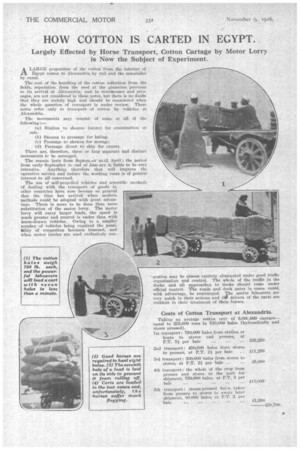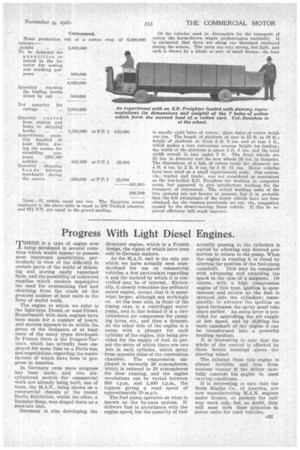HOW COTTON IS CARTED IN EGYPT.
Page 88

Page 89

If you've noticed an error in this article please click here to report it so we can fix it.
Largely Effected by Horse Transport, Cotton Cartage by is Now the Subject of Experiment. Motor Lorry
ALARGE proportion of the cotton from the interior of Egypt comes to Alexandria by rail and the remainder by ,canal.
The cost of the handling of the cotton collection from the fields, separation from the seed at the ginneries previous to its arrival. at Alexandrin, and in storehouses and pressages, are not considered in these_notes, but there is no doubt that they are unduly high and should be considered when the whole question of transport is under review. These notes refer only to transport of cotton by vehicles at Alexandria.
The movements may consist of some or all of the following :— (a) Station to shouna (store) for examination or .sale.
(b) Shouna to pressage for baling.
(c) Pressage to shounn for storage.
(d) Pressage direct to ship for export.
There are, therefore, three or four separate and distinct movements tc be arranged.
The season lasts from Septem,er trail April ; the period from early September to end or' January is liable to be very ,intensive. Anything therefore that will improve the operative service and reduce the working costs is of general interest to all concerned.
The use of self-propelled vehicles and scientific methods of .dealing with the transport of goods in other countries have now become so general that the time has arrived when modern methods could be adopted with great advantage. There is more to be done than mere substitution of the motor lorry. The motor lorry will carry larger loads, the speed is much greater' and control is easier than with horse-drawn vehicles. Owing to a smaller number of vehicles being required the pOSSi, bility 'of congestion becomes lessened, and when motor lorries are used exclusively con ••-gestion may be almost entirely eliminated under good traffic organization and control. The whole of the traffic in the docks and all approaches to docks should come under official control. The roads and dock gates in cases could, with advantage, be rearranged. The native labourers are very quick in their actions and OP drivers of the carts are ruthless in their treatment of their horses.
Costs of Cotton Transport at Alexandria.
Taking an average cotton cror of 6,00(.,000 cantarsequal to 255,000 tons in 750,000 bales (hydraulically and steam pressed).
1st transport: 750,000 hales from station or boats to stores and presses, at P.T. 3i per bale ... £26,250 2nd transport : 450,000 bales from stores to presses, at P.T. 2f per bale . . i11,250 3rd transport : 200,000 bales from stores to stores, at P.T. 21 per bale ... .. £5,000 4th transport: the whole of the crop from presses and stores to the port for shipment, 750,000 bales, at P.T. 2 per bale £15,000 5th transport: steam-pressed balsa taken from presses to stores to awarc later shipment, 60,000 bales, at PT. 2 per bale £1,200 £58,700
Of the vehicles used in Alexandria for the transport of cotton the horse-drawn wagon predominates naturally. It is estimated that there are about one thousand employed during the season. The earts are very strong, but light, and each is drawn by a single or pair of small horses ; the load
is usually eight bales of cotton; three bales of cotton weigh one ton. The length of platform of cart is 15 ft. to 16 ft.; height of platform at front 2 ft. 3 ins, and at rear 3 ft., which makes a very convenient average height for loading; the width of the platform is about 3 ft. 3 ins, and the total width overall is just under 5 ft. The front wheels are 20 ins. in diameter and the rear wheels 28 ins, in diameter. The dimensions of a bale of cotton ready for shipment are 4 ft. 4 ins. by 2 ft. 9 ins. by 1 ft. 11 ins. lklotor vehicles have been tried on a small experimental scale. One system, viz., tractor and trailer, was not considered so convenient as the low-bodied S.D. Freighter for working in congested areas, but appeared to give satisfactory working for the transport of cottonseed. The actual working costs of the two systems are not known at present, but it is probable that the full advantages of the motor vehicle have not been obtained, for the reasons previously set out, viz., congestion caused by the slower-moving horse vehicle. If this be replaced efficiency will much improve.












































































































































































































